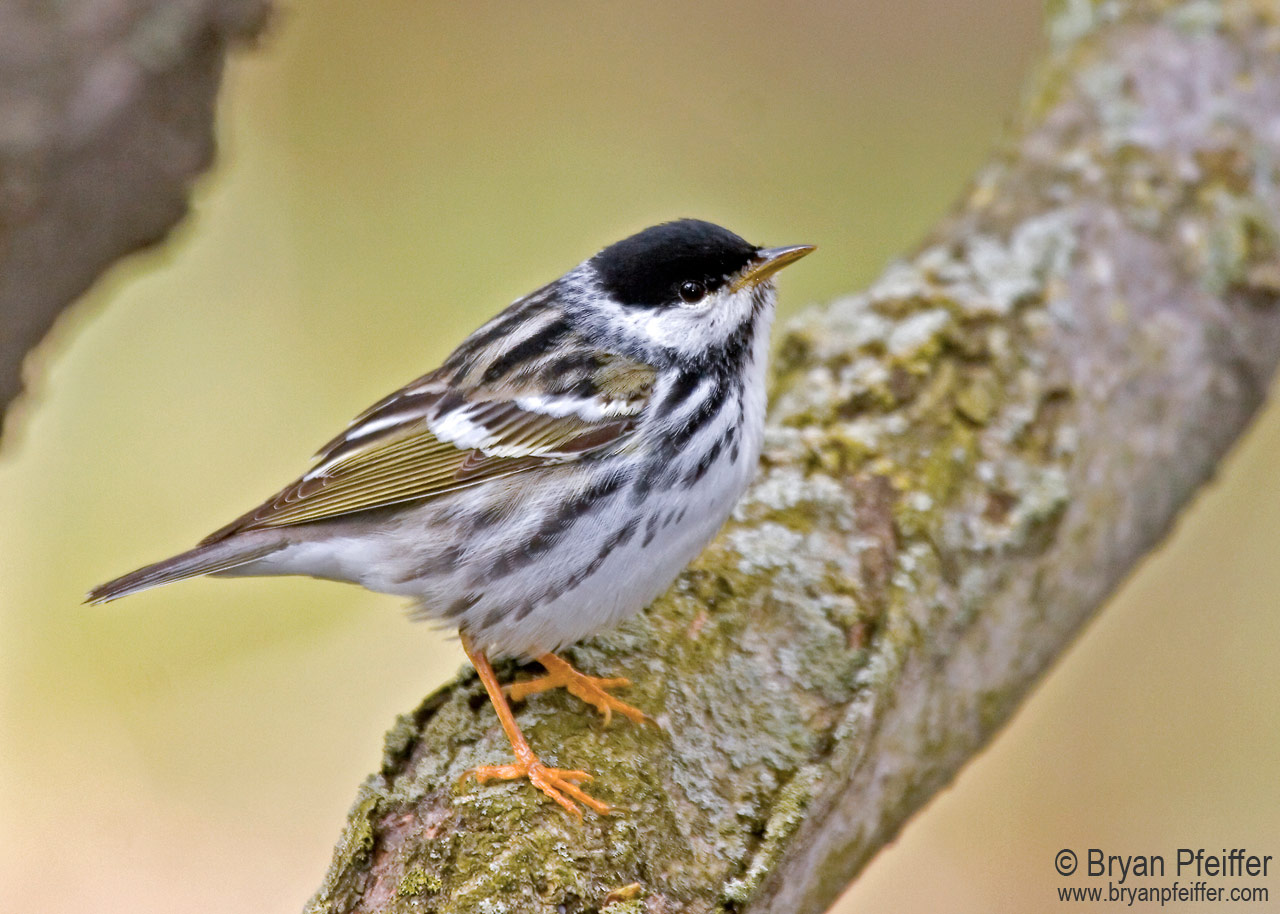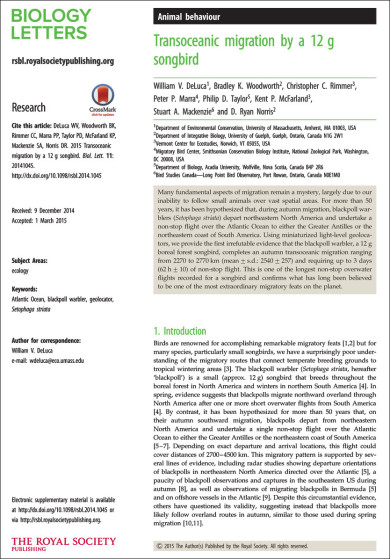 VCE has helped to document one of the most amazing feats of migration on the planet: the Blackpoll Warbler’s flight over the Atlantic Ocean non-stop for up to three days.
VCE has helped to document one of the most amazing feats of migration on the planet: the Blackpoll Warbler’s flight over the Atlantic Ocean non-stop for up to three days.
Blackpoll Warblers fitted with miniature tracking devices took off from points in either Nova Scotia or the northeastern U.S. and flew south over the Atlantic, with no safe place to land, until reaching Caribbean islands roughly 1,600 miles away.
“This is one of the most ambitious migrations of any bird on earth,” said VCE’s Executive Director, Chris Rimmer, co-author of a research paper published today on the warbler flights. “We’ve also documented one of the longest nonstop, overwater flights ever recorded for a songbird.”
Listen to Vermont Public Radio’s interview with Chris about the research.
Although other birds — albatrosses, sandpipers and gulls, for example — are known for trans-oceanic flights, the Blackpoll Warbler is a forest dweller, an iconoclast migrating boldly where few of its relatives dare travel. The vast majority of migratory songbirds that winter in South America take a less risky, continental route south through Mexico and Central America. A water landing would be fatal to a warbler.

One of our research subjects fitted with a geolocator / © VCE
After reaching the islands of Hispaniola and Puerto Rico, the study’s warblers rested, fed and took off again, this time to cross the Caribbean Sea toward wintering destinations in either northern Colombia or Venezuela.
The research, published today in the journal Biology Letters, confirms what birders have long suspected, with only circumstantial evidence, about the unusual flight path of the warblers, which nest in forests across northern North America.
“Many migratory songbirds, blackpolls included, are experiencing alarming population declines for a variety of reasons,” said William DeLuca, the paper’s lead author and an ecologist at the University of Massachusetts. “If we can learn more about where these birds spend their time, particularly during migration, we can begin to examine and address what might be causing the declines.”
To track the flights, the VCE and our colleagues in 2013 captured warblers here in Vermont and Nova Scotia and fitted them with miniature devices called “light-level geolocators,” which resemble songbird backpacks. The warblers migrated south in the fall, spent a winter in the tropics, then returned in spring to North American breeding sites, where we recaptured five birds, removed their geolocators and downloaded their flight itineraries.
Four warblers, including two from Vermont, had departed between Sept 25 and Oct 21 from points somewhere between western Nova Scotia and western Long Island or New Jersey, and flew day and night over the Atlantic Ocean until landing in either Hispaniola or Puerto Rico. Their flight times ranged from 49 to 73 hours.
A fifth bird, which we had also first captured in Vermont, likely took a shorter trans-oceanic trip. It departed the mainland on November 4 from Cape Hatteras and then flew nearly 1,000 miles non-stop for 18 hours later to land in Turks and Caicos before continuing on to South America.
On the return trip north, the blackpoll warblers took a more westerly route, flying to Cuba or Florida, then moving north along the eastern U.S. seaboard before arriving back on the breeding grounds in Vermont and Nova Scotia in late May.
 Why the warblers choose the ocean route isn’t exactly clear. Normally taking weeks or months to complete, migration can be the most perilous part of a songbird’s life. We suspect that Blackpoll Warblers balance the risks of a trans-oceanic flight with the benefits of a speedy and determined migration. And we know that blackpolls essentially double their weight in the fall by accumulating body fat, which helps power the warblers during the long flights.
Why the warblers choose the ocean route isn’t exactly clear. Normally taking weeks or months to complete, migration can be the most perilous part of a songbird’s life. We suspect that Blackpoll Warblers balance the risks of a trans-oceanic flight with the benefits of a speedy and determined migration. And we know that blackpolls essentially double their weight in the fall by accumulating body fat, which helps power the warblers during the long flights.
The research is making its way around the world today in news accounts.
“There was a lot of controversy for a long time about whether they were able to do this, or whether they were doing this,” Wayne Petersen, director of the Massachusetts Important Bird Area program for Mass Audubon, told the Boston Globe. “This is unequivocal. It demonstrates what a lot of people believed but were never able to absolutely conclusively show.”
Unlike GPS devices, which are too large and heavy for the warblers, geolocators use miniaturized sensors to detect and record solar light-level data hundreds of times each day. These data are stored on a tiny computer chip and can be downloaded only if the birds are recaptured. Daily locations can then be inferred from calculations based on day length and the timing of solar noon and midnight.
VCE also reported on this research here on the blog last June, when some of the warblers were returning with their geolocators.
Additional coauthors in the research include collaborating scientists from the University of Guelph, Smithsonian Migratory Bird Center, Acadia University, University of Exeter, and Bird Studies Canada-Long Point Bird Observatory.
The paper in Biology Letters is: Transoceanic migration by a 12 g songbird. William V. DeLuca, Bradley K. Woodworth, Christopher C. Rimmer, Peter P. Marra, Philip D. Taylor, Kent P. McFarland, Stuart A. Mackenzie, D. Ryan Norris. Biol. Lett.: 2015 11 20141045; DOI: 10.1098/rsbl.2014.1045. Published 1 April 2015.
Comments (2)
Pingbacks (4)
-
[…] In this latest study, published in the academic jounal Biology Letters (citation below), the authors explain that several fundamental aspects of migration remain a mystery, mainly because of our inability to follow small animals over great distances. […]
-
[…] migration by a 12 g songbird”. Surse: University of Massachusetts at Amherst, Biology Letters, Vermont Center for Ecostudies, The […]
-
[…] Dr. DeLuca said: […]
-
[…] You can find out more here, from The Boston Globe: http://www.bostonglobe.com/metro/2015/03/31/tiny-blackpoll-warbler-makes-mind-boggling-nonstop-migration/xrfuOBZn7uo5NadrZiV1UN/story.html and from the Vermont Center for Ecostudies: https://vtecostudies.org/blog/the-blackpoll-warblers-daring-ocean-migration/ […]

We were on a cruise NCL Sky midnight may 5 2016 – between stirrup cay and Nassau. Huge flock around ship for long time during thunderstorm many landed rested ran into walls -I was worried about them – and only since looked up and read up -so left this reference on their flight path for you
Why don’t we study racing pigeons returning from a race then we would no were they go